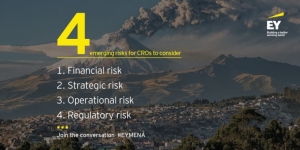عرض العناصر حسب علامة : اصحاب المصالح
الخميس, 16 سبتمبر 2021 10:08
كيف تستعد للمخاطر التي لا يمكنك التنبؤ بها؟
معلومات إضافية
-
المحتوى بالإنجليزية
The age of transformation and disruption was already bringing on new risks for businesses and demanding a different way of thinking. Add a global pandemic to the mix and risk management becomes a critical component to how organizations will manage the future of their business.
Organizations in both the public and private sector in the MENA region are currently facing challenges that are opening them up to risks they may not have accounted for. These include changes to the way of working, such as the need to manage the balance of people on the ground and the increased use of tech to allow remote access.
While government entities and private organizations have mostly mitigated the immediate challenges of the pandemic, there are four emerging risks that Chief Risk Officers (CROs) need to take into consideration when advising stakeholders:
1) Financial risk: The ability to continue to secure financial sustainability for any organization, whether through driving efficiency or managing cashflow
2) Strategic risk: The ability to develop a dynamic strategy that would cater to the changing environment and new way of doing business
3) Operational risk: The ability to drive an efficient and profitable operating model with a good balance between people, the use of technology, and processes
4) Regulatory risk: Whether an organization’s current regulatory framework caters to new circumstances
In order to regain stakeholder and consumer trust, CROs should facilitate discussions with other leaders about the future of the business and securing a resilient operating model.
When reviewing the organization’s risk profile and how to best mitigate new risks, CROs need to prioritize:
· The need to challenge the current strategy and rethink risk protocol in light of the change to how people are interacting with organizations and conducting their lives
· How to cater to the quickly changing needs of their audience and the new norm of doing business
· Being conscious of dynamic changes and what a new future will bring – whether that involves new technology, financial, or operating models – and addressing those challenges as well
· Addressing the talent pool and the skills and tools they will need to work in this new business environment
· Creating a new way of reporting that includes real-time insights to keep stakeholders and board members updated on the full scope and scale of risks as well as how they are impacting different business units
In the past year, many organizations in the MENA region re-examined their protocols for both internal management and audience engagement as they navigated the implications of the pandemic. It has spurred a movement among C-suite and board members to encourage innovation and the use of technology at scale to support the changing needs of employees and consumers. The willingness of an organization to invest in automation in parallel to their risk and compliance function will help build improved resilience into the evolving risk environment. And that investment in risk is how to create trust among stakeholders.
The views reflected in this article are the views of the author and do not necessarily reflect the views of the global EY organization or its member firms.
نشر في
موضوعات متنوعة
موسومة تحت

